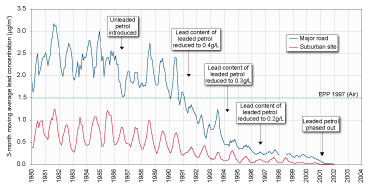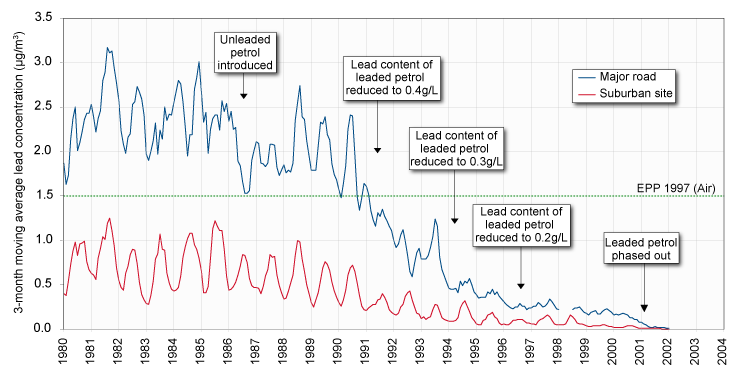Metals

Metals occur naturally in small quantities in the air, water and soil. In the air, metals can exist as vapour or particles.
Mining, metal casting and other industrial processes contribute to metal emissions to the air.
Humans can breathe in metal particles or consume metals in their food and water.
Some metals, such as lead, cause adverse health effects.
The most common metals include:
Lead (Pb)
Lead in its elemental form is a soft grey metal commonly used in the manufacture of a wide range of products like batteries and solders.
The major emission source now is from the mining, smelting and processing of mineral ores.
Until the removal of leaded petrol in Queensland in March 2001, the major source of airborne lead was from motor vehicle emissions from the addition of tetraethyl lead in motor vehicle fuels.
With the removal of leaded petrol, airborne lead has reduced to negligible levels in urban areas.
By 2004 lead levels in Brisbane had fallen to less than 0.02µg/m3, even next to major roads, and analysis for lead in particle samples collected next to roads ceased.
The reduction in lead levels in Brisbane is shown in this graph.

Inhaling or consuming lead and its compounds can affect the human body, particularly the nervous system, and may result in growth and developmental problems in children.
Many houses built before the 1970s used paints containing lead. Renovation of old houses can disturb the old paint. Care should be taken to avoid exposing yourself, your family, your neighbours or your pets to lead residues. Read the Lead alert—six step guide to painting your home fact sheet for more information.
Blood lead concentrations below 0.1 microgram per millilitre (µg/mL) do not present symptoms of lead exposure.
To protect human health, the Environmental Protection (Air) Policy 2019 (EPP Air) objective for airborne lead is set at 0.5 micrograms per cubic metre (µg/m3) based on an annual average. This takes into account the slow rate of removal from the body and is low enough to maintain blood lead levels below 0.1µg/mL.
Arsenic (As)
Elemental arsenic does not occur naturally but its compounds are widespread, often occurring with metal-bearing ores and released during processing. It is widely used in timber preservatives and pesticides, and is well-documented as an occupational hazard.
Inhaling arsenic over a long period may lead to lung cancer. If ingested, arsenic has both an acute poisoning effect and a long-term chronic effect, which may show as skin lesions or cancers of internal organs.
Cadmium (Cd)
Cadmium compounds occur naturally in the environment, particularly in areas of mineralisation. The major emission source is the processing of metal ores for lead, zinc and copper, where cadmium is a valuable by-product.
Its major use is in metal plating and battery making.
Cadmium is classified as a cancer-forming agent. Inhaling cadmium over a long period may lead to lung cancer. It may also cause kidney disease.
The most common pathway for general exposure is by ingesting foodstuffs that have retained cadmium, or through smoking.
Copper (Cu)
Because of its conductive properties, copper is common in electrical wiring and devices.
Copper compounds are ingredients in wood treatment chemicals and pigments.
Mining and metal manufacturing and the processing and transport of copper bearing ores are the largest emission sources of copper in Australia.
Copper is one of a number of essential metals, and a small daily intake is required to maintain a healthy life. However, ingesting high levels of the element can lead to adverse health effects, as some of its compounds are toxic.
Zinc (Zn)
Zinc occurs widely in nature, and is another metal essential in trace quantities for good health.
Exposure to elevated levels is more likely through occupational exposure in industry, including:
- mining
- smelting and processing of metal ores
- metal plating (galvanising).
Zinc and its compounds are widely used in consumer products.
Insufficient zinc intake has a detrimental effect on growth, and immune and reproductive system development. Adverse health effects generally only occur where the exposure is high.
Nickel (Ni)
Nickel is widely distributed in nature, and is another metal essential in trace quantities for good health.
Exposure to elevated levels is more likely in smokers and through occupational exposure in industry, including:
- mining
- smelting and processing of metal ores
- steel and metal alloy production.
Nickel is widely used in steel production and in other metal alloys.
Inhalation of nickel compounds is associated with an increased risk of lung and nasal cancers. Adverse health effects generally only occur where the exposure is high.
Measuring metals
Metals are part of the particles collected on a filter paper by total suspended particulate and PM10 (particles less than 10 micrometres in diameter) high or low volume air samplers.
The metal concentration in the sample is determined by performing a chemical analysis on the filter paper.
The concentration of metal compounds in the air in Mount Isa, and previously in Townsville until 2021) is also measured automatically using x-ray fluorescence (XRF) analysis. XRF is the analysis of the characteristic fluorescent radiation emitted after bombarding the sample with high-energy x-rays.
The instrument samples ambient air through a size-selective inlet and deposits any particles present on a reel-to-reel filter tape. The filter tape automatically advances and the deposited particles analysed for metals at the end of the 1-hour sampling period. This results in a near-continuous analysis. The instrument is capable of analysing more than 20 elements simultaneously.
The live air data service displays concentrations for the most important metals and the regular monthly bulletin for Northern Queensland reports data for these and other metals.
